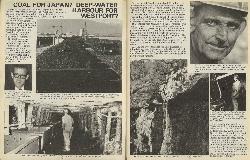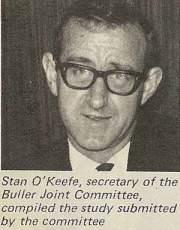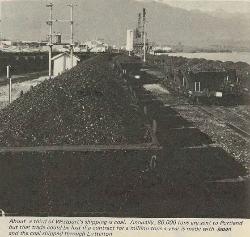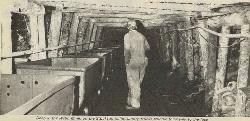12
Coal For Japan?
Deep-Water Harbour For Westport?
A deep-water port for Westport is regarded as the last chance for the area to develop. The West Coast has always been a depressed region but it could make a vital contribution to the national economy, given the opportunity.
In a bid to gain this asset the Buller Joint Committee submitted a well documented case titled "Regional Development Proposal to Government, and a study on the feasibility of such a port was made by an interdepartmental committee.
The joint committee could well have based some of its argument on sentiment, but its entire case revolves around economic fact and projections. Initially the claim for a deep-water port is tied with that traditional life-blood of the West Coast - Coal.
It is estimated that there are about 50 million tons of recoverable coal in the Buller fields and Japanese interests want that coal. Why? Because Buller coal, although high in sulphur, is very suitable for blending with Australian coal for the Japanese steel industry.
Japan has indicated it could take a million tons per year, and more if it could be supplied. Surely this is a sign that the coal industry, which has been slumping, is to be revitalised and the West Coast will benefit.
If a contract with Japan is won the Government will want to make it a paying proposition, so between 70 and 90 miners at present employed in the mines will probably be laid off. Much of the work will be done mechanically and $500,000 worth of mechanical shovel stands ready to be assembled at Stockton. The shovel was originally bought to supply coal to the New Plymouth power project. But when Kapanui gas won its way to the power station, the shovel still had to be taken.
Already the Lyttelton Harbour Board has said it intends to develop facilities to handle the export coal for Japan. This jumping the gun attitude has not gone down well on the Coast, where hopes for a deep-water port have not vanished.
The cost of railing coal from Ngakawau to Lyttelton would be about $3.50 a ton, or 3.5 million dollars annually. At the end of 10 years that cost would be at least 35 million dollars and, with ever increasing costs, probably higher.
Japanese experts consider it would cost about 40 million dollars to build a deep-water harbour. At the end of the 10-year period mentioned, the port would be almost paid for in the saving of transport costs. And the Coast would have an asset bound to attract more industry.
The Forestry Development Conference report on New Zealand's indigenous forests estimates that within the Buller region there are 200,000 acres of virgin (and accessible) beach and beach/podocarp forest, with potential for sustained production. Japanese groups have shown considerable interest in these sources and it is estimated that a pulp industry could export 150,000 tons, worth 21 million dollars, annually.
It is possible a chip and pulp industry, and in the future a paper mill, could be established at Westport. But chips are not an economical proposition if they have to be transported far and unless a chip industry is established initially, the others might not follow. So, again the need for a port capable of taking ships in the 10,000-40,000 ton range is indicated.
The present river port, because of the constant build-up of sand, cannot be developed. But Japanese experts who have visited the area say it is possible to build a deep-water port, running out from North Beach. This is the only suitable locality on the West Coast.
Another valuable resource in the area is mineral deposits. It is estimated that 16 million dollars worth of ilmenite could be exported annually if port facilities were adequate to handle between 10,000 and 20,000 tons.
So we have projected overseas earnings of: Coal — 8 million dollars; Pulp — 21 million dollars; Ilmenite — 16 million dollars.
Westport's case for a deep-water harbour would be easier if it was controlled by a harbour board but the argument had to be presented by the Buller Joint Committee, which is unique in New Zealand. The committee has representatives from the Buller County Council, Westport Borough Council, Buller Electric Power Board, Buller Central Mines Committee, Buller Chamber of Commerce, Buller Hospital Committee, Buller Branch of Federated Farmers, Amalgamated Society of Railway Servants, Railway Tradesmen's Association, Westport Watersiders Union and the Buller Trades Council.
The inter-departmental committee was supposed to have presented its findings to the Minister of Trades and Commerce Mr Shelton two months ago but there has been no word from Government except a "leak" which indicates the committee is against the deep-water port.
The area is subsidised to the tune of 1 1/2 million dollars annually. That drag on the national economy could be replaced with a valuable contribution if a deep-water port evolves from a hope to reality.
Stan O'Keefe, secretary of the Buller Joint Committee, compiled the study submitted by the committee
About a third of Westport's shipping is coal Annually, 80,000 tons are sent to Portland but that trade could be lost if a contract for a million tons a year is made with Japan and the coal shipped through Lyttelton
Deep in the Webb Mine, on the Stockton fields, empty trucks trundle their way to the face






